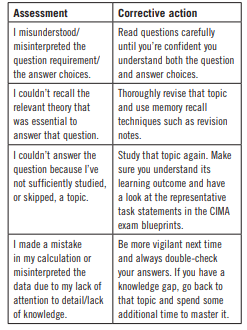July 2021
Question practice is the most effective exam preparation strategy, says CIMA’s Clancy Peiris
Did you know that whenever we ask CIMA students to list the tactics they found most helpful when preparing for their exams, question practice always tops the list? Tuition providers also find that students who practise questions generally pass their CIMA exams on the first try.
Why is question practice so important?
Firstly, it gives you the opportunity to test whether you’ve fully understood what you’ve learned. It enables you to identify which topics you’ve fully grasped as well as the ones you’re yet to master. It’s a simple way to help focus your future study and revision sessions on areas where you didn’t perform well.
Secondly, you’re more likely to retain information if you learn it in multiple, spread-out sessions. Practicing CIMA exam questions will stimulate your memory and recall earlier learning, which in turn is likely to help you improve your ability to retain information. In short, question practice may be more beneficial to you than spending the same amount of time studying.
Thirdly, we found that question practice helps remove some of the mystery around CIMA exams and can reduce exam stress and anxiety, especially if done under mock exam conditions.
The more you get accustomed to sitting for a period of time, answering exam questions, and pacing yourself, the more comfortable you’ll feel on exam day.
Finally, when it comes to computer-based testing, your exam performance can also be impacted by technological issues (e.g. software compatibility) or a lack of familiarity with the testing system. Where possible, I’d advise that you thoroughly test and use the same equipment and software for the exam practice and the actual exam – this will reduce the chances of issues occurring on exam day.
How can I make the most of question practice?
Question practice must be an integral part of your CIMA learning and studying experience.
This means that every time you finish studying a topic, you need to practise doing a few exam questions on that topic. You should also plan to practice questions across the entire CIMA syllabus once you’ve completed all your studying sessions. So when planning your study and revision sessions, make sure to build this into your study plan. Remember that ‘how’ you practise CIMA exam questions is more important than ’how many’ you can do.
Best practices for CIMA OTs: single and multi-choice questions
1: Read the question in full before reviewing the answer options. You need to make sure that you understand what’s expected and that you’ve considered all factors, rather than jumping straight to what seems to be the most logical answer. In multiple-choice exams, not reading the question thoroughly could cost you dearly.
2: Answer the question in your head before reviewing the answer options. This will help prevent you from talking yourself out of the correct answer. It will also give you a chance to reflect and think, making the most of your active recall.
3: Eliminate incorrect answer options before selecting your final answer. Even when you believe you know the right answer, this will help save time by narrowing your answer options and focusing your attention only on potential correct options. Using the process of elimination significantly increases your likelihood of selecting the correct answer.
4: Select the best answer for the question. Many answers may seem correct to you on the first glance, but they’re in fact distractors designed to test your knowledge and skills.
This may seem like a ‘no-brainer’, but you must read every answer option before selecting your final answer – don’t make assumptions! Remember, there’s typically a best answer to the question, and that’s the one you need to find.
5: If you’re unsure, make an educated guess. If you’re having difficulty answering a question, move on. Answer all the questions you know the answers to and come back to tackle the tricky question once you’ve done so.
6: Pay attention to the wording of the answer. In particular, words such as ‘not’, ‘sometimes’, ‘always’, and ‘never’. For example, an answer that includes ‘always’ or ‘never’ must be irrefutable. If you can find a single counter example, then the answer isn’t correct.
7: Take extra care if you see ‘all of the above’ and ‘none of the above’ among the answer choices. Don’t select either of these options unless you’re fully confident that none of the other answer options are either correct or incorrect.
Best practices for CIMA OTs: problem-based questions
1: Thoroughly read the question to understand the problem and take time to think. Clarify what you need to find and determine what the unknown element is. Drawing a sketch on paper will help you break down the problem. It’ll also enable you to think more clearly to find the best approach to solve the problem. Make sure to write down all key information and formulas you think you’ll need to answer the question and devise a plan.
2: Carry out the plan. For numerical problems, be careful and make sure to carry out the calculations carefully in the correct order. It may be a good idea to write down the intermediary answers before moving onto the next step.
3: Sense check your answer. This requires the same quality of thought you originally used to solve the problem. Is your answer what you thought it would be in your original estimate? Is it a quantity that makes sense? Is your answer in the correct units?
4: Let yourself be stuck. Yes, you read this right and I meant it. You need to give yourself a reasonable opportunity to think, recall earlier learning and come out with an approach to find the best solution. When practising, don’t sneak-peek at the suggested or model answer if you get stuck. Keep trying. Build your resilience and only check the answer after you’ve attempted to answer the question.
Enhancing your learning with exam question practice
Question practice will help you assess how far you’ve come with your studies and progressively prepare you for the Strategic Case Study exam, the capstone exam of the CIMA Professional Qualification. To help you get there, you must ensure that you reflect on your performance and put an emphasis on continuously work to improve your exam skills.
1: Identify all questions where you couldn’t find the correct answer. For each question, ask yourself why the answer you provided was incorrect or incomplete.
2: List the reasons why your answer was incorrect or incomplete. Once you’ve done so, write down what actions you can take to ensure that you won’t repeat the same mistakes in your next question practice session and your exam.
3: Reflect on the list. Make sure you fully understand what went wrong, what actions you need to take and what knowledge gap you need to fill before attempting your next practice question.

Where can I find practice questions?
We recommend that you get practice exams from a CIMA Registered Tuition Provider, they’re either paper-based or computer-based. Some of the tuition providers offer practice exams free of charge and others offer them for a fee.
Another option is to use CIMA Aptitude, our official online question bank that simulates an actual CIMA exam. It’s available for all exams of the CIMA Certificate in Business Accounting and CIMA Professional Qualification. CIMA Aptitude is a great complement to your chosen CIMA study method – it’ll enable you to make the most of your exam question practice sessions and assess your exam readiness.
You can use CIMA Aptitude either in practice mode or in a timed assessment mode. For the former, you can attempt questions at your own pace, get instant feedback on your answers and an explanation of the correct answer. This mode allows you to focus on specific areas and practice questions after finishing a topic. For the latter, you can test yourself on 60 questions under exam conditions, get a full feedback report and links back to incorrect answers.
I hope that you found this article to be a helpful guide to question practice, and that you can now see how you can include and build up this active learning method into your study plan to complement your passive learning (e.g. reading, attending a lecture). One final word of caution though, question practice reinforces and supports your CIMA learning but it’s not a replacement for studying! You can read more on the perils of practice questions here.
• Clancy Peiris, Senior Learning Development Manager, Association of International Certified Professional Accountants (AICPA & CIMA)



